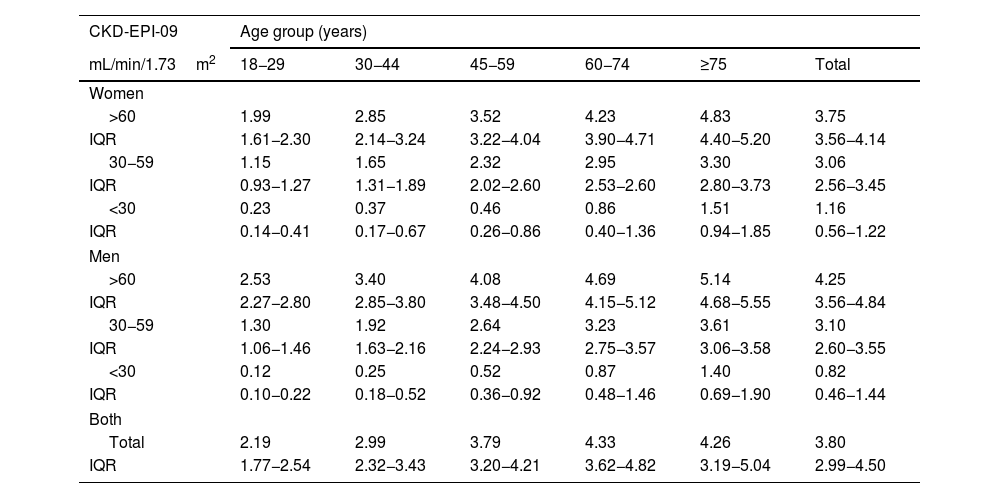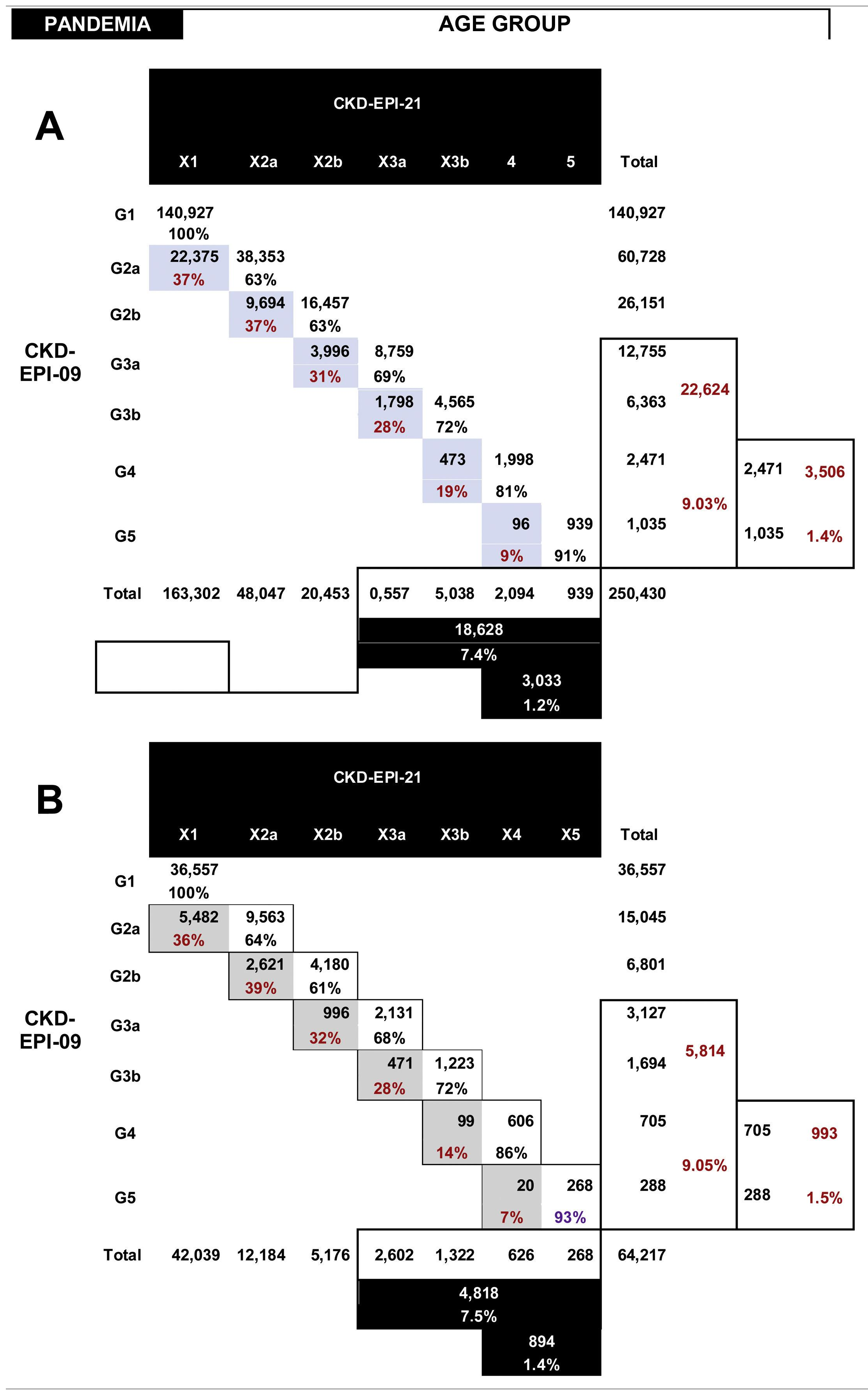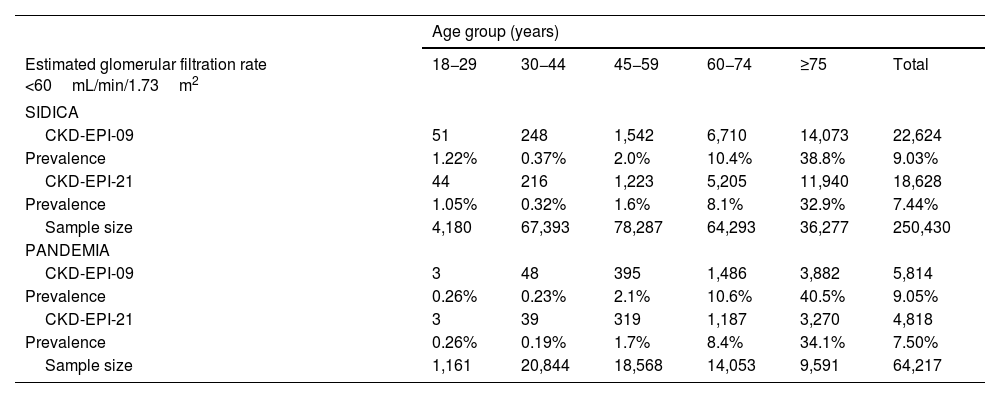United States nephrology societies recommend changing from the CKD-EPI 2009 equation to the new CKD-EPI 2021 equation, which does not include the race coefficient, for calculating estimated glomerular filtration rate (eGFR). It is unknown how this change might affect the distribution of kidney disease in the predominantly Caucasian Spanish population.
MethodsTwo databases of adults from the province of Cádiz, DB-SIDICA (N=264,217) and DB-PANDEMIA (N=64,217), that had plasma creatinine measurements recorded between 2017 and 2021 were studied. Changes in eGFR and the consequent reclassification into different categories of the KDIGO 2012 classification resulting from substituting the CKD-EPI 2009 equation for the 2021 equation were calculated.
ResultsCompared to the 2009 equation, CKD-EPI 2021 yielded a higher eGFR, with a median of 3.8mL/min/1.73m2 (IQR 2.98–4.48) in DB-SIDICA and 3.89mL/min/1.73m2 (IQR 3.05–4.55) in DB-PANDEMIA. The first consequence was that 15.3% of the total population in DB-SIDICA and 15.1% of the total population in DB-PANDEMIA were reclassified into a higher category of eGFR, as were 28.1% and 27.3%, respectively, of the population with CKD (G3-G5); no subjects were classified into the more severe category. The second consequence was that the prevalence of kidney disease decreased from 9% to 7.5% in both cohorts.
ConclusionsImplementing the CKD-EPI 2021 equation in the Spanish population, which is predominantly Caucasian, would increase eGFR by a modest amount (greater in men and those who are older or have a higher GFR). A significant proportion of the population would be classified into a higher eGFR category, with a consequent decrease in the prevalence of kidney disease.
Las sociedades estadounidenses de nefrología recomiendan cambiar la ecuación CKD-EPI 2009 por la nueva CKD-EPI 2021, que no incluye el coeficiente de raza, para estimar la tasa de filtrado glomerular (TFGe). Se desconoce cómo podría afectar este cambio a la distribución de la enfermedad renal de la población española predominantemente caucásica.
MétodosSe estudiaron dos cohortes de adultos de la provincia de Cádiz, BD-SIDICA (n=264.217 personas) y BD-PANDEMIA (n=64.217), que disponían de mediciones de creatinina plasmática entre 2017−2021. Se calcularon los cambios de la TFGe y la consecuente reclasificación en las diferentes categorías de la clasificación KDIGO-2012 al modificar la ecuación CKD-EPI 2009 por la de 2021.
ResultadosEn comparación con la ecuación de 2009, CKD-EPI-21 arrojó una TFGe más alta con una mediana de 3,8mL/min/1,73m2 (IQR 2,98−4,48) en BD-SIDICA y de 3,89mL/min/1,73m2 (IQR 3,05−4,55) en BD-PANDEMIA. Como primera consecuencia, del total de la población, el 15,3% en BD-SIDICA y el 15,1% en BD-PANDEMIA y el 28,1% y el 27,3%, respectivamente, de la población con enfermedad renal (G3-G5) se reclasifió a una categoría de TFGe más alta y ningún sujeto a una más grave. Como segunda, la prevalencia de la enfermedad renal disminuyó del 9% al 7,5% en ambas cohortes.
ConclusionesImplementar la ecuación CKD-EPI-21 en la población española, predominantemente caucásica, aumentaría la TFGe en una cantidad modesta (mayor en hombres y con mayor edad o TFG) y una proporción importante de la población se clasificaría en una categoría de TFGe superior, con la consiguiente disminución de la prevalencia de la enfermedad renal.
Article
Diríjase desde aquí a la web de la >>>FESEMI<<< e inicie sesión mediante el formulario que se encuentra en la barra superior, pulsando sobre el candado.

Una vez autentificado, en la misma web de FESEMI, en el menú superior, elija la opción deseada.

>>>FESEMI<<<











